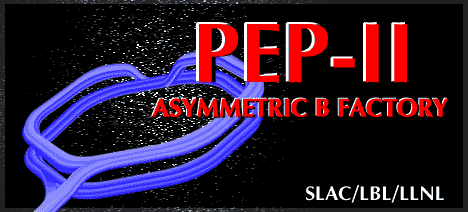 02/11/98 Update
02/11/98 Update
 02/11/98 Update
02/11/98 Update
To: ALL_HANDS
From: John_Seeman.ACCELERATOR@QMAIL.SLAC.STANFORD.EDU
Date: Wed, 11 Feb 1998 18:20 -0800 (PST)
Subject: PEP-II Update End of Run
PEP-II Update February 10, 1998
Our January 1998 run ended in a flurry of activity.
The Low Energy Ring (LER) had a solid week of e+ beam into Arc 7 (90 m). The corrector/position-monitor transfer functions were all measured. The injection kicker was turned on and the dipole strength, timing, and polarity were checked. The injection apertures were scanned. The injection energy was set to the full 3.1 GeV.
The High Energy Ring (HER) achieved a stored beam of 750 mA in 1222 bunches. This came with five RF stations, all RF feedback loops on, the transverse feedback on and six bunch gaps (but without the longitudinal feedback due to lack of power amplifiers). We stored 650 mA with one bunch gap and 1650 bunches. The 750 mA was achieved during the last shift January 31 and with no hard current limit seen. The beam was completely stable and useable for collisions up to over 500 mA. Some longitudinal motion was seen above that current.
The feedback groups did grow-damp experiments and determined that the longitudinal growth rates are about as expected. The transverse growth rates for the largest modes are about ten times faster than expected. Damping this rate is still within the capabilities of the transverse feedback system. Speculations on the increased rate now center on ion effects.
The streak camera (Alan Fisher, Alex Lumpkin (APS), Ralph Assmann, John Byrd (ALS)) measured the bunch length to be about right (1.1 mm). They also made interesting movies of the longitudinal motion along the bunch train under different fill patterns and currents. This device was very useful in achieving the large stored current.
The software to ramp all the magnets (for scanning the 4S resonance) was tested and successfully ramped a stored beam from 9.0 to 9.1 GeV.
At 750 mA the vacuum system still shows "no sign of (thermal) stress under near operational conditions" as quoted from Uli Wienands (system manager).
A small mountain of background data was taken and analysis of this will take a few weeks.
Our future schedule is to inject e+ into the first half of the LER the first ten days of May and then to run the full month of July with both rings, storing the first beam in the LER and looking for first collisions. The accelerator is off for August and September for site transformer work. We will then run both rings from October to December 1998. Babar roll-on is to start in January 1999.
This was a very satisfying run to the credit of many-many people.
We also wish to thank the several visitors who helped during our run including Wilhelm Bialowons and Mark Lomperski from DESY, Bruno Zotter and Massimo Placidi from CERN, and David Sutter from the DOE.
Thanks again to all-----John Seeman
Suggestions to: John Seeman
[PEP-II Commissioning Updates] [PEP-II Home Page] [BABAR Detector Home Page] [SLAC Home Page]
Page owner: achan